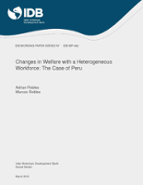Changes in Welfare with a Heterogeneous Workforce: The Case of Peru
Date
Mar 2016
This paper argues that the assumption of a homogeneous workforce, which is implicitly invoked in the decomposition analysis of changes in welfare indicators, hides the role that schooling and its returns may have on the understanding of these changes. Using Peruvian cross-sectional data for a period of ten years (2004-2013) and counterfactual simulations, this paper finds that the main factor contributing to poverty reduction has been individuals' changes in labor earnings, and the role of these changes has been less important in reducing income inequality. The main driving force of reduced income inequality has been the fall in returns to education, which at the same time has been one of the important factors to constraining the period's remarkable progress in poverty reduction and expansion of the middle class.



